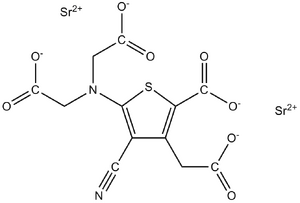Strontium ranelate
Stroncium-ranelate is used in medicine as an anti-osteoporotic agent , which has a dual mechanism of action on bone – it increases bone formation and at the same time reduces bone osteoresorption. It is also effective in the elderly and in clinically risky situations (e.g. in the case of bone fragility syndrome). The strontium ranelate molecule contains two Sr 2+ ions bound to an organic carrier – ranelic acid.
Indication[edit | edit source]
Long-term treatment reducing the risk of vertebral and non-vertebral fractures or fractures of the proximal femur in complicated osteoporosis . The treatment is primarily intended for the treatment of osteoporosis in women after menopause and for the treatment of osteoporosis in men with an increased risk of fractures.
Contraindications[edit | edit source]
Venous thromboembolism (also in the anamnesis), cardiovascular diseases (ischemic heart disease, strokes, arterial hypertension, diseases of peripheral arteries).
Interactions[edit | edit source]
The bioavailability of strontium ranelate is reduced by the simultaneous administration of milk, milk products and preparations containing calcium, as well as some antacids. On the other hand, strontium ranelate reduces the absorption of tetracycline and quinolone antibiotics. Simultaneous administration of bisfosphonates or raloxifeneis considered inappropriate.
Adverse effects[edit | edit source]
The most common adverse effects leading to discontinuation of treatment were nausea and diarrhea, headaches or skin reactions. Very common side effects include musculoskeletal pain. Common ones include cardiovascular disorders (thromboembolism, acute myocardial infarction), hepatitis, bronchial hyperreactivity,vertigo and others.
![]() As of January 2014, the use of strontium renelate is not recommended.[1]
As of January 2014, the use of strontium renelate is not recommended.[1]
Method of administration and dosage[edit | edit source]
In the Czech Republic, strontium ranelate is State Drug Control Office: strontium ranelateavailable in sachets for the preparation of an oral suspension. In the treatment of osteoporosis, 2 g of strontium ranelate is administered daily in a single dose (usually at bedtime 2 hours after dinner). The treatment is long-term.
Links[edit | edit source]
Related Articles[edit | edit source]
Bibliography[edit | edit source]
- OLEJÁROVÁ, Marta. Revmatologie v kostce. 1. edition. Praha : Triton, 2008. 231 pp. ISBN 978-80-7387-115-4.
- Státní ústav pro kontrolu léčiv. Stroncium-ranelát (Protelos) – registrace zůstává platná s dalším omezením používání [online]. ©2014. The last revision 2014-02-27, [cit. 2015-03-18]. <https://www.sukl.cz/stroncium-ranelat-protelos-registrace-zustava-platna-s>.
- BERNABEI, Roberto – MARTONE, Anna Maria – ORTOLANI, Elena. , et al. Screening, diagnosis and treatment of osteoporosis: a brief review. Clin Cases Miner Bone Metab [online]. 2014, vol. 11, no. 3, p. 201-7, Available from <https://www.ncbi.nlm.nih.gov/pmc/articles/PMC4269144/?tool=pubmed>. ISSN 1724-8914.
- REGINSTER, Jean-Yves. Cardiac concerns associated with strontium ranelate. Expert Opin Drug Saf [online]. 2014, vol. 13, no. 9, p. 1209-13, Available from <https://www.ncbi.nlm.nih.gov/pmc/articles/PMC4196504/?tool=pubmed>. ISSN 1474-0338 (print), 1744-764X.
Reference[edit | edit source]
- ↑ PRAC,. European Medicines Agency recommends that Protelos/Osseor remain available but with further restrictions [online]. [cit. 2016-03-16]. <https://www.ema.europa.eu/ema/index.jsp?curl=pages/news_and_events/news/2014/02/news_detail_002031.jsp&mid=WC0b01ac058004d5c1>.

